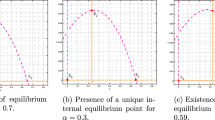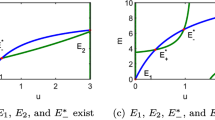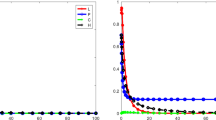Abstract
We study a model of three interacting species in a food chain composed by a prey, an specific predator and a generalist predator. The capture of the prey by the specific predator is modelled as a modified Holling-type II non-differentiable functional response. The other predatory interactions are both modelled as Holling-type I. Moreover, our model follows a Leslie-Gower approach, in which the function that models the growth of each predator is of logistic type, and the corresponding carrying capacities depend on the sizes of their associated available preys. The resulting model has the form of a set of nonlinear ordinary differential equations which includes a non-differentiable term. By means of topological equivalences and suitable changes of parameters, we find that there exists an Allee threshold for the survival of the prey population in the food chain, given, effectively, as a critical level for the generalist predator. The dynamics of the model is studied with analytical and computational tools for bifurcation theory. We present two-parameter bifurcation diagrams that contain both local phenomena (Hopf, saddle-node transcritical, cusp, Bogdanov-Takens bifurcations) and global events (homoclinic and heteroclinic connections). In particular, we find that two types of heteroclinic cycles can be formed, both of them containing connections to the origin. One of these cycles is planar involving the absence of the specific predator. In turn, the other heteroclinic cycle is formed by connections in the full three-dimensional phase space.









Similar content being viewed by others
References
Aguirre, P.: A general class of predation models with multiplicative Allee effect. Nonlinear Dyn. 78, 629–648 (2014)
Aguirre, P.: Bifurcations of two-dimensional global invariant manifolds near a non-central saddle-node homoclinic orbit. SIAM J. Appl. Dyn. Syst. 12, 1600–1644 (2015)
Aguirre, P., González-Olivares, E., Sáez, E.: Three limit cycles in a Leslie-Gower predator-prey model with additive Allee effect. SIAM J. Appl. Math. 69, 1244–1262 (2009)
Aguirre, P., Krauskopf, B., Osinga, H.M.: Global invariant manifolds near homoclinic orbits to a real saddle: (non)orientability and flip bifurcation. SIAM J. Appl. Dyn. Syst. 12, 1803–1846 (2013)
Bazykin, A.: Nonlinear Dynamics of Interacting Populations. World Scientific, Singapore (1998)
Chiu, C.H., Hsu, S.B.: Extinction of top-predator in a three-level food-chain model. J. Math. Biol. 37, 372–380 (1998)
Clark, C.K.: Mathematical Bioeconomic: The Optimal Management of Renewable Resources, 2nd edn. Wiley, New York (1990)
Deng, B.: Food chain chaos due to Shilnikov orbit. Chaos 12, 533–538 (2002)
Deng, B.: Equilibriumizing all food chain through reproductive efficiency. Chaos 16, 043125 (2006)
Doedel, E.: Lecture notes on numerical analysis of nonlinear equations. In: Krauskopf, B., Osinga, H.M., Galán-Vioque, J. (eds.) Numerical Continuation Methods for Dynamical Systems, pp. 1–49. Springer, New York (2007), Underst. Complex Syst., Chap. 1
Doedel, E.J., Oldeman with major contributions from, B.E., Champneys, A.R., Derole, F., Fairgrieve, T.F., Kuznetsov, Y., Paffenroth, R.C., Sandstede, B., Wang, X.J., Zhang, C.H.: AUTO-07p Version 0.7: Continuation and Bifurcation Software for Ordinary Differential Equations. Department of Computer Science, Concordia University, Montreal, Canada (2010), available from http://cmvl.cs.concordia.ca/
Dumortier, F., Roussarie, R., Sotomayor, J., Zoladek, H.: Bifurcations of Planar Vector Fields. Lecture Notes in Mathematics, vol. 1480. Springer, Berlin (1991)
González-Olivares, E., Rojas-Palma, A.: Allee effect in Gause type predator-prey models: existence of multiple attractors, limit cycles and separatrix curves. A brief review. Math. Model. Nat. Phenom. 8, 143–164 (2013)
González-Olivares, E., Sáez, E., Stange, E., Szántó, I.: Topological description of a non-differentiable bioeconomics model. Rocky Mt. J. Math. 35(4), 1133–1155 (2005)
González-Olivares, E., Mena-Lorca, J., Rojas-Palma, A., Flores, J.D.: Dynamical complexities in the Leslie-Gower predator-prey model as consequences of the Allee effect on prey. Appl. Math. Model. 35(1), 366–381 (2011)
González-Olivares, E., González-Yánez, B., Mena-Lorca, J., Flores, J.D.: Uniqueness of limit cycles and multiple attractors in a Gause-type predator-prey model with nonmonotonic functional response and Allee effect on prey. Math. Biosci. Eng. 10, 345–367 (2013)
Guckenheimer, J., Holmes, P.: Nonlinear Oscillations, Dynamical Systems, and Bifurcations of Vector Fields. Springer, New York (1983)
Hannesson, R.: In: Bioeconomic Analysis of Fisheries. Fishing, New Books (1993)
Haque, M., Ali, N., Chakravarty, S.: Study of a tri-trophic prey-dependent food chain model of interacting populations. Math. Biosci. 246(1), 55–71 (2013)
Hasík, K.: On a predator-prey system of Gause type. J. Math. Biol. 60, 59–74 (2010)
Hastings, A., Powell, T.: Chaos in a three-species food chain. Ecology 72, 896–903 (1991)
Khoshsiar-Ghaziani, R., Alidoustia, J., Bayati-Eshkaftaki, A.: Stability and dynamics of a fractional order Leslie-Gower prey-predator model. Appl. Math. Model. 40, 2075–2086 (2016)
Kuznetsov, Y.: Elements of Applied Bifurcation Theory. Applied Mathematical Sciences. Springer, Berlin (2004)
Kuznetsov, Yu.A., De Feo, O., Rinaldi, S.: Belyakov homoclinic bifurcations in a tritrophic food chain model. SIAM J. Appl. Math. 62, 462–487 (2001)
Leslie, P.H.: Some further notes on the use of matrices in population mathematics. Biometrika 35, 213–245 (1948)
Mccann, K., Yodzis, P.: Bifurcation structure of a three-species food-chain model. Theor. Popul. Biol. 48, 93–125 (1995)
Mukherjee, D.: The effect of prey refuges on a three species food chain model. Differ. Equ. Dyn. Syst. 22(4), 413–426 (2014)
Rosenzweig, M.L.: Paradox of enrichment: destabilization of exploitation ecosystems in ecological time. Science 171, 385–387 (1971)
Sáez, E., Szántó, I.: A polycycle and limit cycles in a non-differentiable predator-prey model. Proc. Indian Acad. Sci. Math. Sci. 117(1), 219–231 (2007)
Sáez, E., Stange, E., Szántó, I., González-Olivares, E., Falconi, M.: Chaotic dynamics and coexistence in a three species interaction model. Int. J. Biomath. 08, 1550022 (2015)
Sahoo, B., Poria, S.: Oscillatory coexistence of species in a food chain model with general Holling interactions. Differ. Equ. Dyn. Syst. 22(3), 221–238 (2014)
Saputra, K.V.I., van Veen, L., Quispel, G.: The saddle-node-transcritical bifurcation in a population model with constant rate harvesting. Discrete Contin. Dyn. Syst., Ser. B 14(1), 233–250 (2010)
Sharma, S., Samanta, G.P.: Dynamical behaviour of a two prey and one predator system. Differ. Equ. Dyn. Syst. 22(2), 125–145 (2014)
Singh, A., Gakkhar, S.: Stabilization of modified Leslie-Gower prey-predator model. Differ. Equ. Dyn. Syst. 22(3), 239–249 (2014)
Turchin, P.: In: Complex Population Dynamics, A Theorical/Empirical Sythesis. Monograps in Populations Biology, vol. 35, pp. 89–118 (2003)
Walters, C.J.: Adaptive Management of Renewable Fisheries. Macmillan Co., London (1986)
Acknowledgements
We thank professor Eduardo González-Olivares for suggesting the study of non-differentiable predation models and for his invaluable comments and advice.
Author information
Authors and Affiliations
Corresponding author
Additional information
Publisher’s Note
Springer Nature remains neutral with regard to jurisdictional claims in published maps and institutional affiliations.
V.R. was funded by PIIC DGIIP-UTFSM. P.A. was partially funded by CONICYT-FONDECYT Iniciación grant 11150306 and Proyecto Basal CMM-U. de Chile
Rights and permissions
About this article
Cite this article
Rivera, V., Aguirre, P. Study of a Tritrophic Food Chain Model with Non-differentiable Functional Response. Acta Appl Math 165, 19–43 (2020). https://doi.org/10.1007/s10440-019-00239-3
Received:
Accepted:
Published:
Issue Date:
DOI: https://doi.org/10.1007/s10440-019-00239-3




